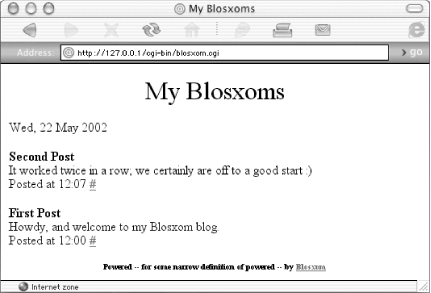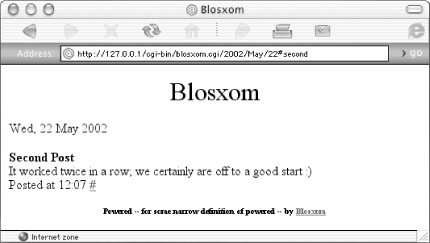Section 9.6. Viewing Your Blog
Point your web browser at the Blosxom CGI script. If you're running Blosxom on your local machine, the URL will probably be something like: http://localhost/cgi-bin/blosxom.cgi/. On a service provider's web server, you'll most likely find Blosxom at http://www.myprovider.com/~sam/cgi-bin/blosxom.cgi/, where myprovider.com is your provider's domain and sam is your username.
If all goes as planned, you should see something along the lines of Figure 9-1, your first two blog entries in Blosxom's default look and feel ? such as it is.
Figure 9-1. Viewing your blog

Each day begins with the date, followed by weblog entries for that day in reverse-chronological order ? the latest entries rise to the top. Each entry consists of a title, body, time of posting, and a permalink (the # bit) to the entry itself for easy reference.
The look and feel is completely customizable (see Section 9.10 later in this chapter).
9.6.1 The Archives
Of course, pointing at your weblog's URL provides only the latest view with only the last few postings. Blosxom provides automatic virtual archives for your posts as well.
Appending a slash, the four-digit year, another slash, and the three-letter month abbreviation or two-digit month number transports you back to a particular month. For example, appending /2002/May displays only entries for May 2002, /1999/01 those for January 1999.
Appending to the month view yet another slash, followed by the two-digit day (padding the 1st through the 9th with a 0), displays entries for a particular day. For instance, /2002/May/22 shows entries for May 22, 2002, /1999/Jan/01 those for New Years Day, 1999.
To zoom in on a single entry, append a slash, pound (#), and the entry's filename without the .txt extension. Thus, /2002/05/22#second or /2002/May/22#second displays entries for May 22nd and scrolls down to the "second" blog entry ? the contents of the file, second.txt (see Figure 9-2). The URL for a specific entry is known as the entry's permalink and is the preferred form of referring to an entry rather than the day as a whole or the weblog's home page.
Figure 9-2. Viewing a particular entry by its permalink URL







